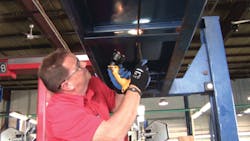Tech Tip: In-shop lift maintenance keeps equipment functioning properly
Technicians should make a habit of checking their vehicle lifts daily prior to using them. Unsure of what to look for? Here are some guidelines from the Automotive Lift Institute (ALI):
Two-post and inground lift telescoping arms
- Check over-travel stops for wear.
- Examine arms for stress cracks, weld breaks or permanent bending.
- Check swivel points and lubricate if needed.
Two-post and four-post lift chains and cables
- Check chains and/or cables for stretch or wear; have the system serviced if excessive slack or wear is present.
- Inspect end connections for corrosion and deformation.
- Remove any salt, sand, water, dirt or debris from chain system.
Hydraulic systems
- Maintain hydraulic fluid level per lift manufacturer's requirements.
- Make sure the return lines to the reservoir are tightly connected.
- Check seals, packing and wipers for blow-by or oil leaks.
- Inspect plungers for nicks, dings and dents.
Information provided by: Automotive Lift Institute (ALI)
